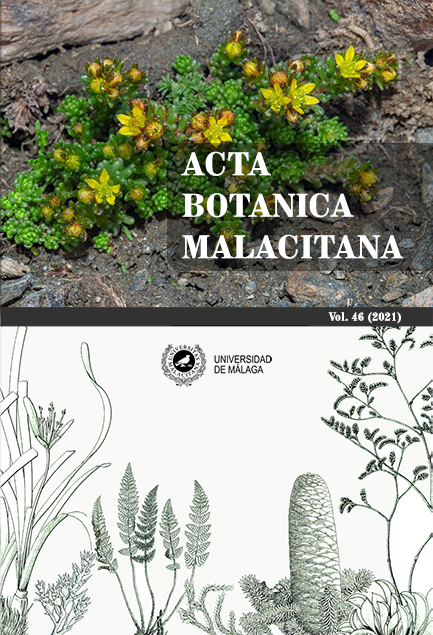Typification of two names in the genus Punica L. (Lythraceae)
DOI:
https://doi.org/10.24310/abm.v46i.11730Palabras clave:
Linnaeus, neotype, nomenclature, pomegranate, Punicaceae, Socotria protopunicaResumen
Se discute la tipificación de los nombres Punica nana L. y Punica protopunica Balf. f. El nombre linneano es neotipificado usando un espécimen completo conservado en VAL (Herbario del Jardí Botànic de la Universitat de València). El nombre Punica protopunica es lectotipificado a partir de un espécimen original recolectado por Schweinfurth en Socotra y conservado en K (Herbario de Kew).
Descargas
Métricas
Citas
Al Shawish, F., Hamed, F. & Al-Issa, I. (2006). Evaluation of some qualitative and chemical characteristics for the most important pomegranate (Punica granatum) accessions in Yemen. Damascus University Journal of Agricultural Science, 22, 227–241.
APG IV (2016). An update of the Angiosperm Phylogeny Group classification for the orders and families of flowering plants: APG IV. Botanical Journal of the Linnean Society 181, 1–20.
Balfour, I.B. (1882). Diagnoses plantarum novarum et imperfect descriptarum Phanerogamarum Socotrensium; quas elaboravit Bayley Balbour, Scientiae Doctor et in Universitate Glascuensi rerum botanicarum regius professor. Pars Prima. Proceedings of the Royal Society of Edinburgh, 11, 498–514.
Balfour, I.B. (1888). Botany of Socotra. Transactions of the Royal Society of Edinburgh, 31, 1–446
Bennett, M.D. & Leitch, J.J. (2005). Nuclear DNA amounts in Angiosperms: progress, problems and prospects. Annals of Botany, 95, 45–90.
Cappellini, E., Prohaska, A., Racimo, F., Welker, F., Pedersen, M.W., Allentoft, M.E., Damgaard, P.D.B., Gutenbrunner, P., Dunne, J., Hammann, S., Roffet-Salque, M., Ilardo, M., Víctor Moreno-Mayar, J., Wang,1 Martin Sikora, Y., Vinner, L., Cox, J., Evershed, R.P. & Willerslev, E. (2018). Ancient biomolecules and evolutionary inference. Annual Review of Biochemistry, 87, 1029–1060.
Chandra, R., Babu, K.D., Jadhav, V.T., Jaime, A. & Silva, T.D. (2010). Origin, history and domestication of pomegranate. Fruit, Vegetable and Cereal Science and Biotechnology, 2, 1–6.
El Deeb, K.S., Eid, H.H., Ali, Z.Y., Shams, M.M. & Elfiky, A.M. (2019). Bioassay-guided fractionation and identification of antidiabetic compounds from the rind of Punica granatum var. nana. Natural Product Research, 22, 1–4.
Guarino, L. Miller, T., Baazara, M. & Obadi, N. (1990). Socotra: The island of Bliss revisited. Diversity 6(3–4), 28–31.
Guerrero-Solano, J.A., Jaramillo-Morales, O.A., Jiménez-Cabrera, T., Urrutia-Hernández, T.A., Chehue-Romero, A., Olvera-Hernández, E.G. & Bautista, M. (2020). Punica protopunica Balf., the forgotten sister of the common Pomegranate (Punica granatum L.): features and medicinal properties. A Review. Plants 9(9), 1214, 2–15. 10.3390/plants9091214.
Hajiahmadi, Z., Talebi, M. & Sayed-Tabatabaei, B.E. (2013). Studying genetic variability of Pomegranate (Punica granatum L.) based on chloroplast DNA and barcode genes. Molecular Biotechnology, 55, 249–259.
Hasnaoui, N., Buonamici, A., Sebastiani, F., Mars, M., Zhang, D. P. & Vendramin, G.G. (2012). Molecular genetic diversity of Punica granatum L. (pomegranate) as revealed by microsatellite DNA markers (SSR). Gene 493, 105–112.
Jalikop, S.H. (2010). Pomegranate breeding. Fruit Veg. Cereal Sci. Biotechnol. 4(Special Issue 2), 26–34.
Jarvis, C.E., Barrie, F.R. Allan, D.M. & Reveal, J.L. (1993). A list of Linnaean generic names and their types. Regnum Vegetabile, 127, 1–100.
Jarvis, C.E. (2007). Order out of chaos: Linnaean plant names and their types. London: Linnean Society of London and the Natural History Museum.
Levin, G.M. (1981). Wild pomegranate (Punica granatum L.) in Turkmenistan. [title translated from Russian]. Izvestiia Akademii Nauk Turkmenskoi SSR, Seriia Biol Nauk 2, 60–64.
Levin, G.M. (1994). Pomegranate (Punica granatum L.) plant genetic resources in Turkmenistan. Plant Genetic Resources, 97, 31–36.
Levin, G.M. (2006). Pomegranate. Third Millennium Publishing, Tempe, pp 1–130.
Linnaeus, C. (1753). Species plantarum, vol. 1. Holmiae [Stockholm]: impensis Laurentii Salvii. https://doi.org/10.5962/bhl.title.669
Linnaeus, C., (1762). Species Plantarum. ed. 2. Holmiae [Stockholm]: impensis Laurentii Salvii. https://www.biodiversitylibrary.org/page/11629130#page/692/mode/1up
Luo, X., Li, H., Wu, Z., Yao, W., Zhao, P., Cao, D., Yu, H., Li, K., Poudel, K., Zhao, D., Zhang, F., Xia, X., Chen, L., Wang, Q., Jing, D. & Cao, S. (2020). The pomegranate (Punica granatum L.) draft genome dissects genetic divergence between soft- and hard-seeded cultivars. Plant Biotechnology Journal, 18, 955–968.
Mars, M. (2000). Pomegranate plant material: Genetic resources and breeding, a review. Options Méditerranéennes, 42, 55–62.
Martín-Robles, N., Lehmann, A., Seco, E., Aroca, R., Rillig, M.C. and Milla, R. (2017). Impacts of domestication on the Arbuscular mycorrhizal symbiosis of 27 crop species. New Phytologist, 218, 322–334.
Melgarejo, P. & Martínez, R. (1992). El Granado. Ediciones Mundi-Prensa, S.A., Madrid, 163 pp.
Melgarejo, P., Martínez, J.J., Hernández, F., Martínez, R., Legua, P., Oncina, R., Martínez-Murcia, A. (2009). Cultivar identification using 18S–28S rDNA inter-genic spacer-RFLP in pomegranate (Punica granatum L.). Scientia Horticulturae, 120, 500–503.
Miller, Ph. (1754). Gardeners dictionary, 4th edition. London: J. & J. Rivington. https://www.biodiversitylibrary.org/item/150893#page/150/mode/1up
Miller, Ph. (1768). Gardeners dictionary, 8th edition. London: J. & F. Rivington. https://www.biodiversitylibrary.org/item/10276#page/935/mode/1up
Miller, A.G. & Morris, M. (2004). Ethnoflora of Soqotra Archipelago. Edinburgh: The Royal Botanic Garden.
Narzary, D., Rana, T.S. & Ranade, S.A. (2010). Genetic diversity in inter-simple sequence repeat profiles across natural populations of Indian pomegranate (Punica granatum L.). Plant Biology, 12, 806–813.
Nath, N. & Randhawa, G.S. (1959). Classification and description of sole varieties of Punica granatum L. Indian Journal of Horticulture 16(4), 189–201.
Norouzi, M., Talebi, M., Sayed-Tabatabaei, B.-E. (2012). Chloroplast microsatellite diversity and population genetic structure of Iranian pomegranate (Punica granatum L.) genotypes. Scientia Horticulturae, 137, 114–120.
Özgüven, A.I., Y?lmaz, C. & Kele?, D. (2012). Pomegranate biodiversity and horticultural management. Acta Horticulturae, 940, 21–28.
Rana, J.C., Pradheep, K.& Verma, V. (2007). Naturally occurring wild relatives of temperate fruits in Western Himalayan region of India: an analysis. Biodiversity Conservation, 16, 3963–3991.
Shilikina, I.A. (1973). On the xylem anatomy of the genus Punica L. Botanicheskii Zhurnal 58, 1628–1630 .
Sylvain, G. & Thomas, B. (2010). A comparative view of the evolution of grasses under domestication. New Phytologist, 183, 273–290.
Teixeira da Silva, J.A., Rana, T.S., Narzary, D., Verma, N., Meshram, D.T. & Ranade, S.A. (2013). Pomegranate biology and biotechnology: a review. Scientia Horticulturae, 160, 85–107.
Tournefort, J. P. de (1719). Institutiones rei herbariae; Editio tertia, Appendicibus aucta ab Antonio de Jussieu Lugdunaeo, Doctore Medico Parisiensi, Botanices Professore, Regiae Scientiarum Academiae, & Regiae Societatis Londinensis Socio. Tomus primus. Parisiis: E Typographia Regia.
Turland, N.J., Wiersema, J.H., Barrie, F.R., Greuter, W., Hawksworth, D.L., Herendeen, P.S., Knapp, S., Kusber, W.–H., Li, D.–Z., Marhold, K., May, T.W., McNeill, J., Monro, A.M., Prado, J., Price, M.J. & Smith, G.F. (Eds.) (2018). International Code of Nomenclature for algae, fungi, and plants (Shenzhen Code) adopted by the Nineteenth International Botanical Congress Shenzhen, China, July 2017. Regnum Vegetabile 159. Glashütten: Koeltz Botanical Books. https://doi.org/10.12705/Code.2018
Verma, N., Mohanty, A. & Lal, A. (2010). Pomegranate genetic resources and germplasm conservation: A review. Fruit, Vegetable and Cereal Science and Biotechnology, 4, 120–125.
Descargas
Publicado
Cómo citar
Número
Sección
Licencia
Toda la información relacionada con la licencia de uso de los trabajos publicados en Acta Botanica Malacitana y con los derechos de autor se pueden consultar en nuestra Política Editorial.







1.png)


